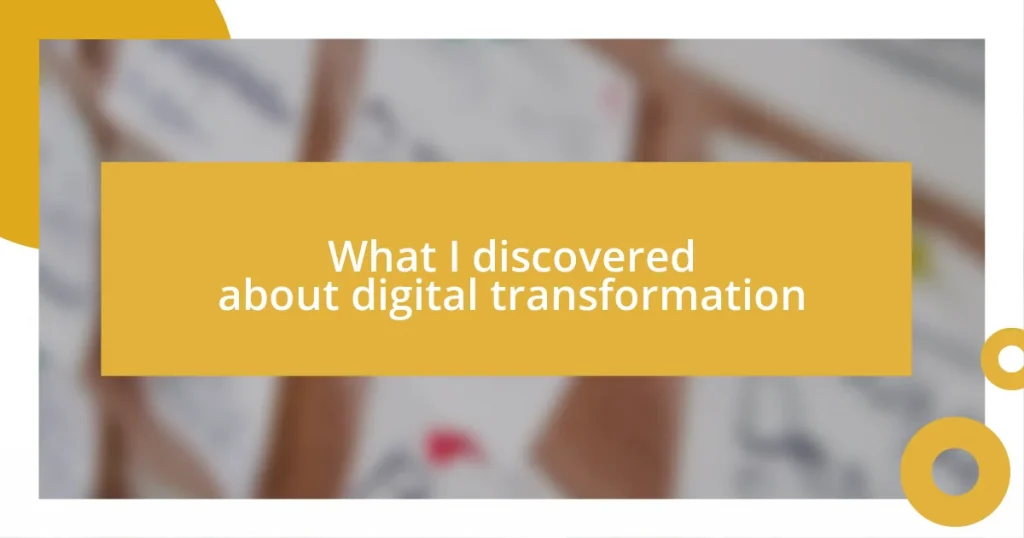Key takeaways:
- Digital transformation is primarily about people and culture, emphasizing adaptability and a willingness to learn alongside technology adoption.
- Key drivers include customer expectations, technological advancements, competitive pressure, operational efficiency, and cultural shifts that require organizations to innovate continually.
- Success in digital transformation hinges on clear metrics, employee engagement, ongoing education, and adapting strategies based on customer feedback and financial analysis.
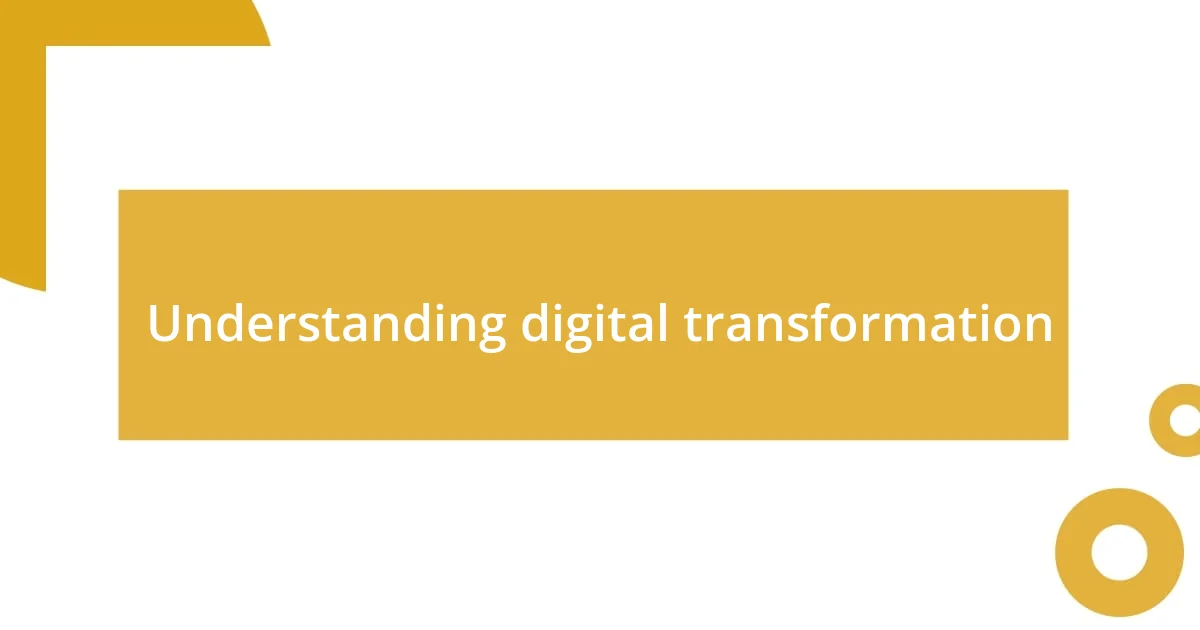
Understanding digital transformation
Digital transformation is more than just a buzzword; it’s a profound shift in how organizations operate and deliver value. I remember when my own company decided to dive into this journey; the energy in the room was palpable, but so were the fears of the unknown—would we lose the essence of what made us unique?
At its core, digital transformation involves adopting new technologies while fostering a culture that embraces change. I saw firsthand how this approach not only improved efficiency but also bolstered teamwork. Have you ever felt that rush of excitement when a new tool simplifies a task? That’s the magic of embracing digital tools; they can turn daunting challenges into opportunities for connection and creativity.
What struck me the most during this process was the realization that digital transformation is not just about technology—it’s about people. One day, I witnessed a colleague find joy in learning a new software tool that, at first glance, seemed intimidating. Seeing that shift in perspective made me ponder: how many businesses overlook the human element in the quest for digital advancement? Ultimately, it’s our adaptability and willingness to learn that truly drive transformation.
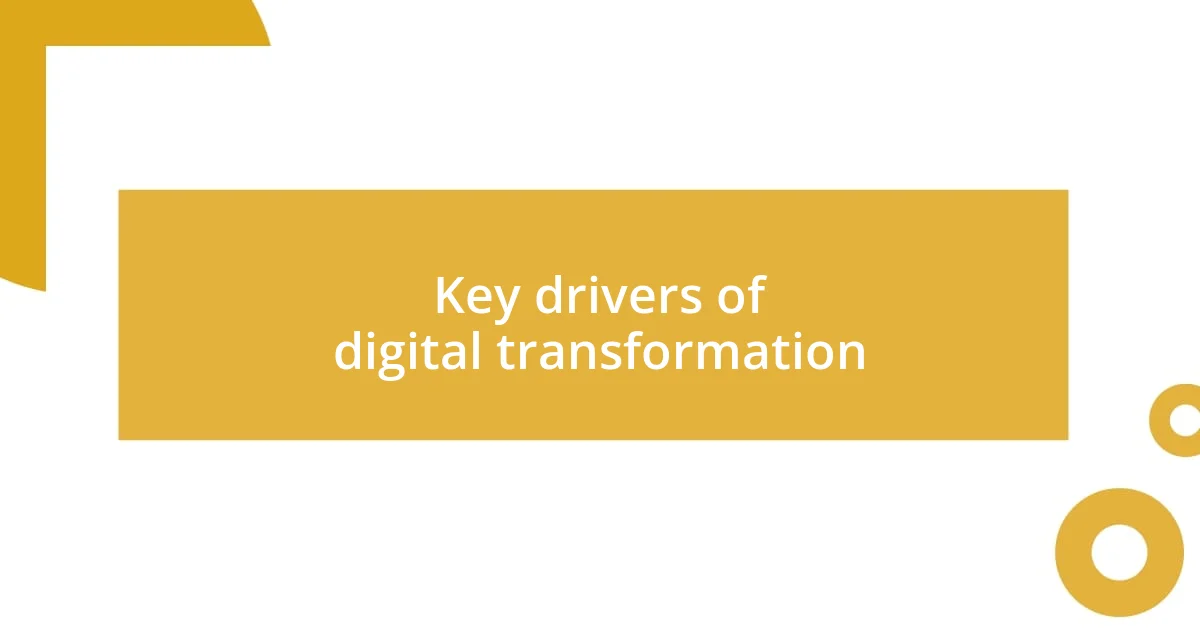
Key drivers of digital transformation
The key drivers of digital transformation can often be traced back to an organization’s desire to stay competitive and relevant. I recall when my team faced declining sales; the urgency to adopt new technologies became obvious. It was about more than just improving our bottom line; it was about survival.
Here are some essential drivers that fuel this transformation:
- Customer Expectations: Modern consumers demand seamless experiences across channels. I remember when some of our customers voiced their frustration with outdated service; listening to their feedback pushed us to innovate rapidly.
- Technological Advancements: Rapid advancements in technology, like artificial intelligence and cloud computing, have paved the way for significant improvements. I often think back to the moment we integrated AI tools; the efficiency and insights we gained were staggering.
- Competitive Pressure: In today’s market, standing still equates to falling behind. The realization struck me hard when a competitor launched an app that changed the game; we knew we had to follow suit to retain our share.
- Operational Efficiency: With digital tools, organizations can optimize processes and reduce costs. I once saw our team cut project timelines by half with the adoption of a project management tool; it not only saved time but boosted morale significantly.
- Cultural Shifts: As organizations shift towards a more collaborative environment, embracing digital tools becomes essential. I remember when we introduced regular digital brainstorming sessions, and the energy stemming from new ideas was exhilarating.
Recognizing these drivers is crucial; they not only shape how we proceed but also determine our culture as we transform.
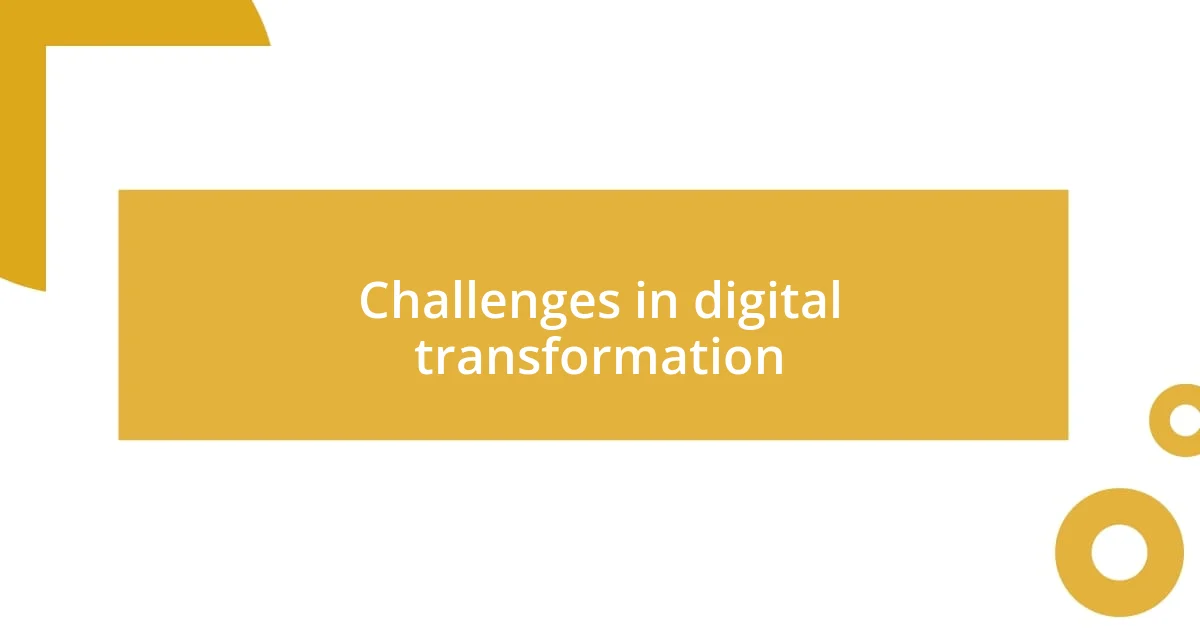
Challenges in digital transformation
As organizations embark on digital transformation, they often face a multitude of challenges. From my perspective, addressing resistance to change is paramount. I recall a pivotal moment when team members were hesitant to let go of their familiar processes. Their concerns were valid, but it was fascinating to witness how open dialogue could ease fears. Change can feel daunting, but once we stepped back to discuss potential benefits and offer training, the atmosphere shifted significantly.
Another major challenge lies in aligning technology with business goals. I remember when we introduced a shiny new software, only to realize it didn’t directly support our strategic objectives. It was a wake-up call that led us to invest time in understanding how our choices could drive value. To me, it underscores the importance of thorough planning and constant reassessment during such transformations.
Moreover, the data security aspect cannot be overlooked. I once felt a wave of anxiety when I learned about potential vulnerabilities in our new system. It was a stark reminder that while we leap into innovation, safeguarding our information must always be a priority. Balancing progress with security is a tightrope walk that I believe every organization must master.
| Challenge | Personal Insight |
|---|---|
| Resistance to Change | Team discussions can transform apprehension into enthusiasm. |
| Technology Alignment | Understanding strategic goals enhances the value of new tools. |
| Data Security | Prioritizing security is crucial as you adopt new technologies. |
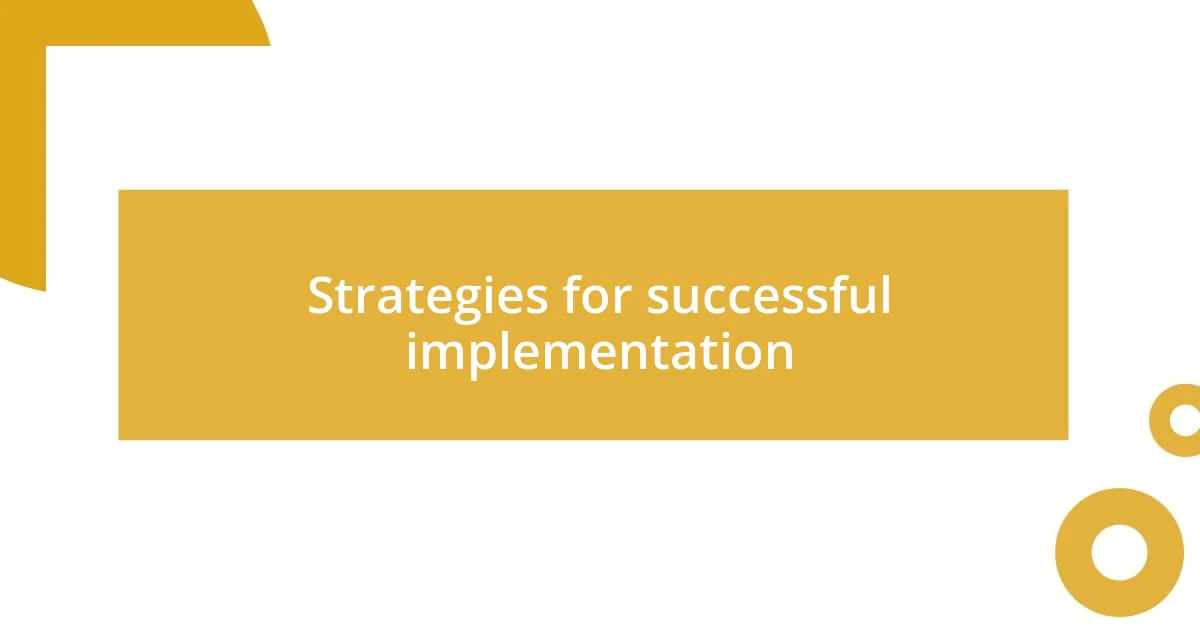
Strategies for successful implementation
Successful implementation of digital transformation projects requires a well-thought-out strategy. One of the most effective strategies I’ve found is fostering a culture of adaptability and openness. For instance, I once facilitated a team workshop where we explored our fears around new technology. The result was not just increased buy-in but a wave of creative ideas for leveraging those tools. Isn’t it interesting how simply talking about apprehensions can turn them into opportunities?
Another valuable strategy is prioritizing customer feedback throughout the implementation process. I vividly recall receiving real-time insights from customers during a beta phase of our new digital tool. Their suggestions weren’t just helpful; they completely reshaped our final product. This experience reinforced my belief that engaging users can dramatically improve outcomes. How often do we really ask customers what they want before launching something new?
Lastly, never underestimate the power of continuous education and support. I remember feeling overwhelmed when we rolled out a complex system; it felt like we were drinking from a firehose. By offering ongoing training and creating a support network, we turned confusion into competence. This approach not only empowered our team but also cultivated a spirit of collaboration. Have you ever felt that sense of achievement when the pieces finally fall into place after the initial chaos?
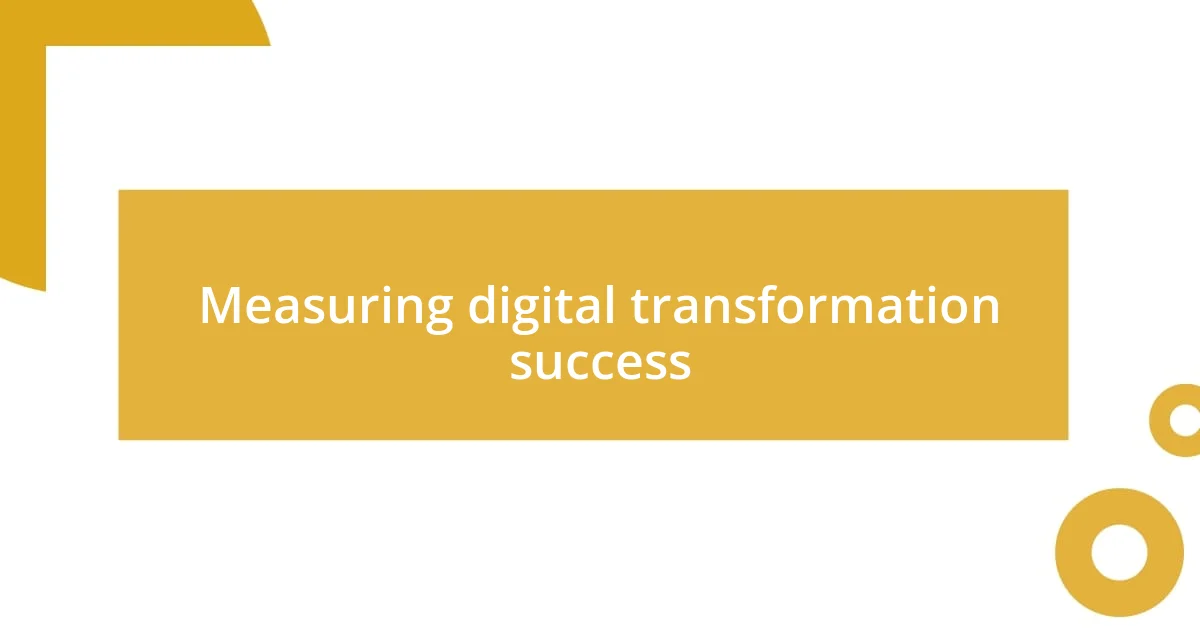
Measuring digital transformation success
Measuring the success of a digital transformation initiative can often feel like navigating a maze. I’ve learned that it’s essential to define clear metrics from the start. For instance, when we adopted a CRM system, we established KPIs such as customer satisfaction scores and response times. These specific indicators offered tangible proof of our progress, helping us adapt our strategy in real-time.
One key aspect that stood out to me during our evaluation process was the importance of employee engagement. After implementing new technologies, we hosted surveys to gauge team morale and usability feedback. I vividly remember the surprise and relief when we discovered that engagement levels had increased. Isn’t it fascinating how technology doesn’t just enhance operations, but can also uplift the workplace culture?
Additionally, financial metrics serve as a critical measure of transformation success. I recall crunching numbers after launching an e-commerce platform; the revenue growth was significant, but I also realized we needed to analyze customer acquisition costs. Understanding this allowed us to refine our marketing efforts effectively. This experience helped me appreciate that success isn’t just about immediate profit but also about long-term sustainability and growth. How comfortable are you with evaluating the financial impact of your digital initiatives?
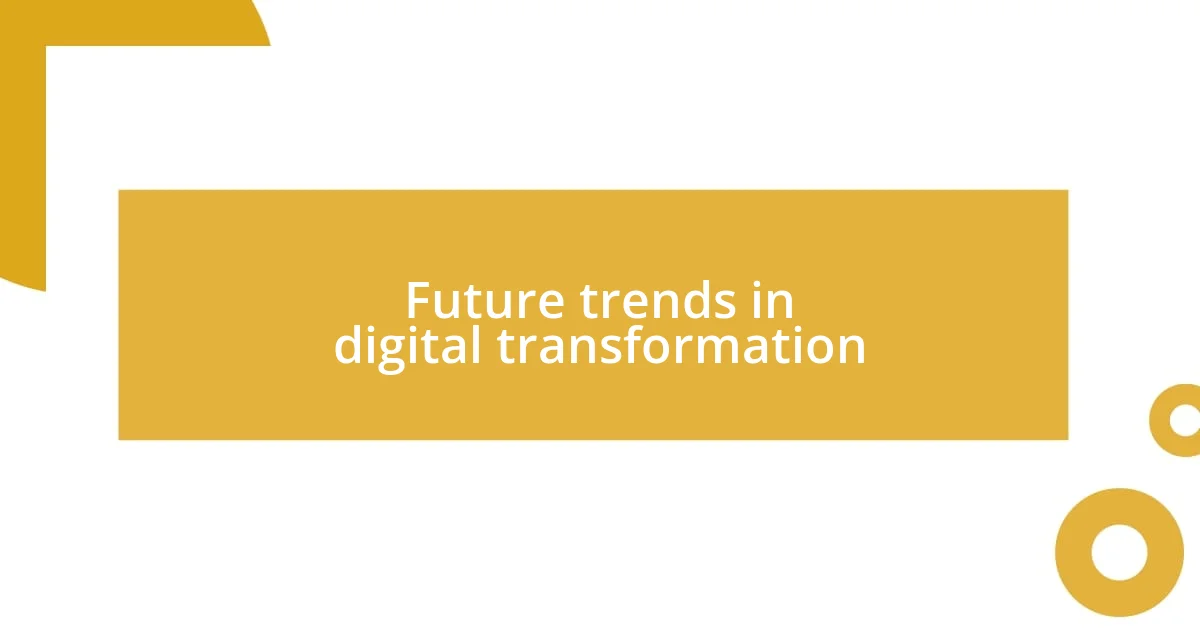
Future trends in digital transformation
It’s fascinating to think about where digital transformation is headed in the near future. One trend I’m particularly excited about is the rise of artificial intelligence (AI) and machine learning in customer service. I remember watching a demonstration of an AI chatbot that not only handled inquiries but learned from each interaction, becoming more efficient over time. Have you ever interacted with AI and felt like it understood you better than a human? This level of personalization can dramatically enhance customer experiences and drive loyalty.
Another significant trend is the integration of digital twins in business operations. While I initially found the concept a bit overwhelming, I soon realized the potential it holds. A digital twin is a virtual representation of physical assets or processes, allowing organizations to simulate scenarios and optimize performance. I once participated in a pilot program where we created a digital twin of our supply chain, and the insights we gained helped us identify bottlenecks we weren’t even aware of. It’s incredible to consider how this technology could revolutionize not just efficiency, but also innovation across various sectors.
Lastly, I see a growing emphasis on data privacy and security as organizations continue their digital journeys. From my perspective, this aspect can’t be overlooked. When we shifted more services online, it raised my awareness about keeping customer data secure. During a recent training, we discussed privacy regulations and best practices, and I noticed how this not only built trust with our audience but also empowered our team. Have you ever found yourself surprised by how much your approach to security influences your clients’ perceptions? Prioritizing this area can create a solid foundation for all future transformations.
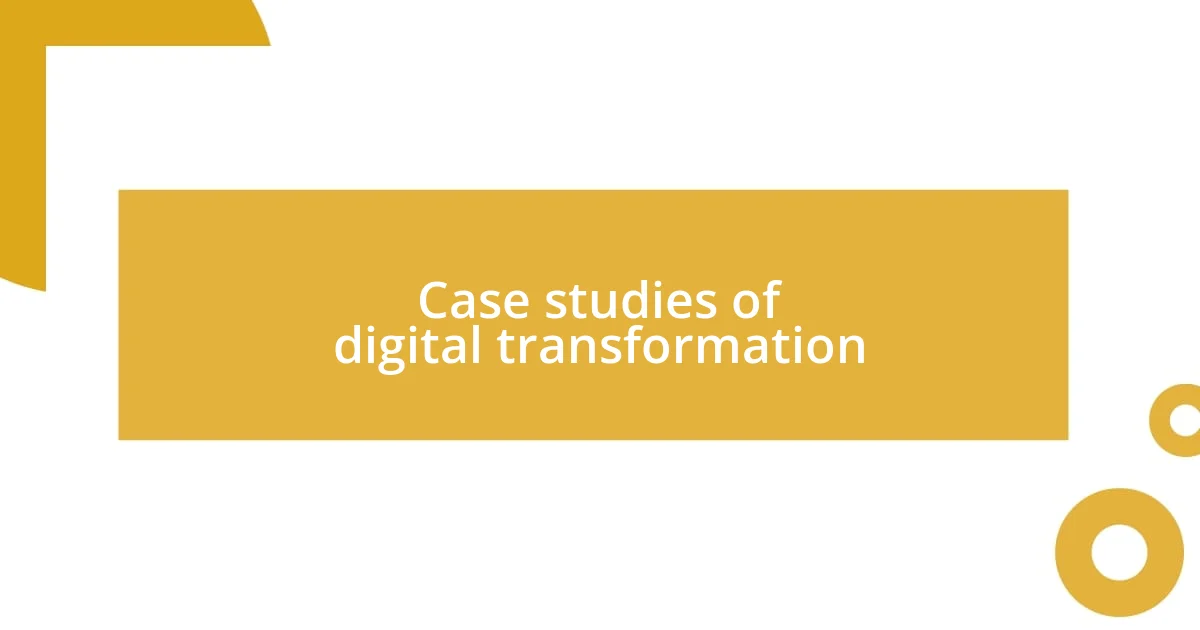
Case studies of digital transformation
One powerful example I encountered during my journey in digital transformation was a retail company that launched an omnichannel strategy. They integrated online and in-store experiences, which, at first, felt daunting. Yet, I remember the excitement among staff when they saw how customers could seamlessly switch between digital and physical shopping. This initiative not only boosted sales but also transformed customer loyalty by creating a consistent brand experience. It made me wonder, how often do you consider the synergy between different shopping channels?
A healthcare organization I worked with took a bold step by implementing a patient management system. Initially, there were hesitations from the staff about changing their routines, which reminded me of my own apprehensive feelings when faced with new technology. However, once the system was in place, I saw firsthand how it streamlined processes and significantly reduced wait times. Reflecting on this shift, I realized that embracing change can lead to remarkable improvements in patient care, even when it feels uncomfortable at first.
In my experience, the journey of digital transformation often involves trial and error, as evidenced by a logistics company that deployed a fleet management tool. They faced challenges during the rollout, including initial resistance from drivers, which was both amusing and eye-opening. Observing their early struggles taught me the importance of user training and creating support systems. Eventually, the tool enhanced route efficiency and reduced costs significantly. Have you ever witnessed a transformation that required patience to see its full potential? It’s energizing to watch organizations evolve through perseverance and adaptability.










